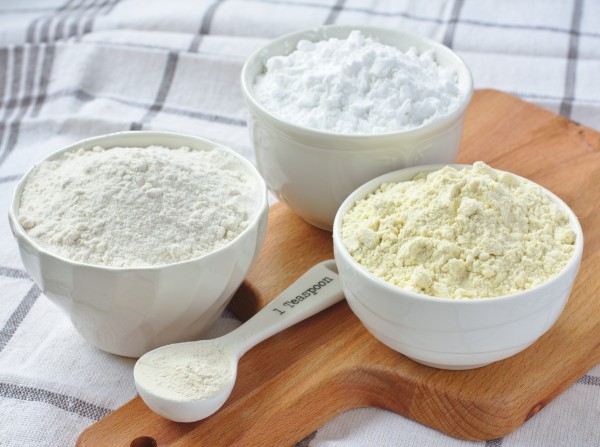Making Your Own Gluten Free Flour Blends
After our popular live cook alongs via our Facebook page this recently demonstrating Gluten Free Bread we had so many requests for a blog on how to make your own Gluten Free Flour mixes. One of the concerns about using gluten free flours is the expense and nutritional quality. Yes, these flours can be more expensive but if you choose a few of the more nutritious options you can make your own blends and use them in a wide range of homemade recipes. I have additional blends and recipes included in my latest book My Kids Can’t Eat That!
Gluten-free baking requires different types of flours, different techniques and different baking times. Gluten helps bind ingredients together, trapping in air to create elasticity in dough and helping breads and cakes to keep light texture and structure. Gluten free flours vary in their characteristics including protein content, taste, density and texture. Some are higher in protein and heavier but often more nutritious. On their own they can create a dense texture so are best when combined with lighter flours which tend to be starchier.
Creating your own blends has the added benefit that you can improve the nutritional profile, add depth of flavour and texture.
Gluten free flour mixes vary in their composition – some use 70% whole grain flours and 30% starchy flours others use a little more starch – which can be better for making pastry for example. If you like using cups rather than grams a good guide is 1 ¼ cup of a protein wholegrain flour (e.g. bean flour, nut flours, buckwheat, quinoa, teff, amaranth), 1 cup of a lighter flour (brown rice, sorghum) and 1 cup starch (often a mix of tapioca, arrowroot or potato). Typically rice flour is combined with more protein rich flours together with starches like arrowroot, cornflour, potato or tapioca starch. To lighten the flour mix you can then add a little baking powder and / or bicarbonate of soda. You’ll find loads of gluten free recipes in my recipe section including our best ever Gluten Free Seeded Bread.
Here’s a list of some of the most popular whole grain gluten free flours
Brown Rice Flour – A useful light flour richer in fibre than regular white rice flour. A good source of B vitamins, manganese and combines well with higher protein flours like sorghum, quinoa, teff and amaranth.
Buckwheat Flour – With its nutty rich flavour this flour is delicious in cakes, pancakes and breads. Good source of protein, fibre and rich in phytonutrients including rutin known for its ability to strength blood capillaries, I like using it with chestnut flour in cakes and muffins.
Amaranth – A staple in the Aztec and Incan diets. Amaranth is a great protein rich four providing plenty of the amino acid lysine which can be low in vegetarian and vegan diets. Good source of iron and fibre too. It’s starch content means it helps with binding too
Sorghum Flour – this is one of my favourites for bread and cakes. It has a nutty, sweet flavour, and fine texture means it works well in cakes. High in antioxidants and good fibre rich option
Chestnut Flour – milled from dried chestnuts this is a sweet and nutty flour. It is quite starchy so good for moist cakes and puddings.
Millet Flour – has almost the same protein content as wheat, and for that reason make a good addition in bread mixes but does have a slightly strong nutty flavour. It does need to be combined with starches like arrowroot or tapioca
Teff Flour – one of my vegan favourites due to its high protein content. Packed with potassium, calcium, iron, fibre and protein it has a lovely rich flavour – it can be dense so combine it with lighter flours.
Quinoa Flour – a good addition in breads and pastry it is incredibly nutritious. With 60% more protein than wheat and a good source of minerals iron, zinc, copper and calcium.
Soya Flour – rich and high in protein. Good added to bread mixes especially those with yeast.
Nut Flours – I often use ground nuts or almond flour in recipes especially if I am making paleo dishes. Rich in monounsaturated fats, vitamin E, fibre, magnesium and potassium they also provide protein to cakes and breads. You can simply grind up nuts in a processor until fine crumbs form.
Almond flour is particularly popular and high in monounsaturated fats, and also in vitamin E, magnesium and potassium, good for heart health.
Coconut flour – a popular paleo flour. It is high in lauric acid. Lauric acid is a healthy saturated fat that’s essential to your immune system. These fats are also important for healthy skin and thyroid function. Because coconut flour comes from the meat of dried coconut, it also contains a good source of protein. Rich in fibre, coconut flour will also aid in healthy digestion and gut health.
Starches
Potato Starch is made from peeled potatoes and is very fine. It helps provide a light but moist texture in baked goods. Very starchy so a little goes a long way.
Tapioca Flour has a sweet flavour and adds a silky texture to baked goods.
Corn Flour or cornstarch is made from very finely ground corn. It is popular as a thickener in sauces, but I use it in pastry and breads too. Polenta is different from cornstarch. It is yellow, and gives baked goods colour and moisture (use like a higher protein flour). Delicious used in cakes and muffins.
Arrowroot – I like using arrowroot as a binding starch in cakes, pastry and breads. It is also a great way to lighten breads.
Gram Flour (chickpea flour) high in protein which can help mixtures to bind and is commonly used as an egg substitute. I sometimes use this in breads to help with binding as well as boosting the protein content.
Gums
During the cook along I mentioned using gums in breads. These are not always needed but do help to bind mixtures especially in pastries. You don’t have to use xanthum or guar gum as there are other options like flaxseed, chia, pysllium husks and pectin powder. In some recipes you can use eggs, yogurt or milk to help bind or some fat like coconut oil or butter. To enrich mixtures, you can also add 20-50g dry milk powder or a nut milk powder.
Basic Gluten Free Flour Mixes
Here’s a few mixes to get you started.
To the following mixes you can add 1tsp xanthum gum or equivalent and / or baking powder depending on what you are using it for.
Basic Flour Mix
Make this healthier – instead of 700g rice flour use 350g buckwheat or sorghum flour and 350g brown rice flour.
700g brown rice flour
200g potato flour
100g tapioca flour
Chestnut Mix – useful for cakes and breads
400g chestnut flour
400g brown rice flour
200g cornflour
Higher Protein Blend
400g soya flour
200g tapioca flour
400g potato flour
300g cornflour
Do check out our recipes for some healthy gluten free options

